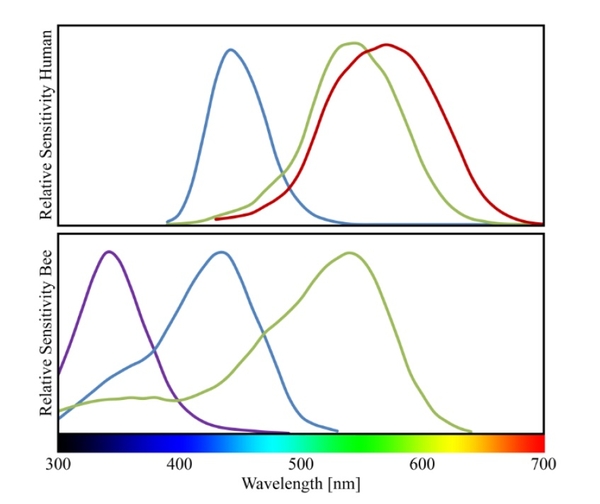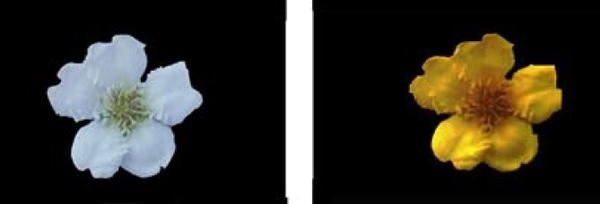Insect vision
Recently we’ve had some club discussion on the use of sticky traps to catch fruit flies, and several members have acquired some goo to try out. Honey bees and fruit flies use many cues to guide them to flowers and fruits, and a relevant question is whether trap colour is enough to attract them, and if so what colour is best? A surrounding question with this approach is how many other insects may also be caught, particularly the ones that are beneficial in the garden. Humans, honeybees and fruit flies have trichromatic vision, ie what is ‘seen’ is a composite of output from three photoreceptor types that feed through neuronal pathways to the brain – for us the three types are blue, green and red, and for them, UV, blue and green (see spectra below, C Verhoeven et al, Journal of Pollination Ecology,(2018) 23, 102-118). Notice how the photoreceptor labels are just broad descriptors, eg ‘green’ receptors aren’t sensitive to only pure green wavelengths. Rather the descriptors indicate where they’re most sensitive and for example the honeybee green receptor can also pick up some yellow wavelengths but at lower sensitivity. We don’t see reflected UV light but if suitable photo-chemicals exist in the specimen we may see a longer wavelength fluorescent signal emitted in the visible spectrum. Without appropriate equipment we don’t know how much UV signalling is going on in specimens, but these two insect types can. As an example (from B-M Song and C-H Lee, Front Neural Circuits (2018), 12:16), the two pictures show two flowers (Crataegus germanica (medlar) and Nonea lutea) that appear sort of whitish to us (ie comparable contributions from blue, green and red), but honeybees see them differently according to how much UV signalling adds into the blue/green, and the wavelengths involved.



Nonea lutea vision (human, bee)
Species of fruit flies such as Mexican fruit fly (Anastrepha ludens), South American fruit fly (Anastrepha fraterculus), cherry fruit fly (Rhagoletis cingulata), apple fruit fly (Rhagoletis pomonella), European cherry fruit fly (Rhagoletis cerasi), walnut husk fly (Rhagoletis completa), olive fruit fly (Bactrocera oleae), Queensland fruit fly, (Bactrocera tryoni, and similar species B. neohumeralis and B. cacuminatus), and the Mediterranean fruit fly (Ceratitis capitata) are most attracted to yellow or fluorescent yellow and this is general for flies of the family Tephritidae (A H Toorani, H Abbasipour, Acta Ag Slovenica (2017), 109, 561-575), but it should be realized that for some fruit tree species you’re trying to protect it might not be the best.